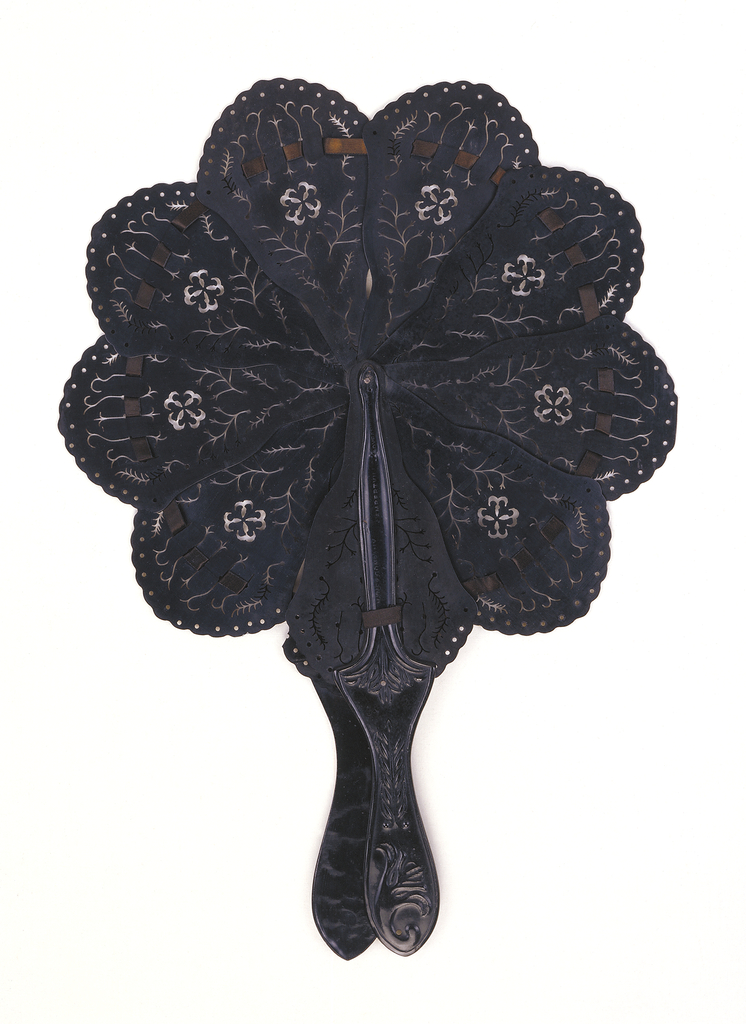At first glance, it is difficult to know how to identify the material composition of this folding fan. The material is black and stiff with a drilled pattern of open decorative elements and a raised design on the handle. On closer examination, the words, “Man’f Company Lambertville Goodyear Patent” can be seen stamped into the top portion of the handle.

Close-up of handle of fan with markings interpreted in yellow text.
With the clues provided by this patent mark, it is possible to extract information about the material and date of the fan. The Lambertville Manufacturing Company, in Lambertville, New Jersey, was active in the 1860s in the production of hard (vulcanized) rubber. It ceased operation in 1868 when the factory was destroyed by fire. Natural (as opposed to synthetic) rubber is a raw material produced from a milky liquid that is tapped from certain tropical trees in South America. The use of natural materials in design often involves technical challenges. For the 2009 exhibition project, Design for a Living World, Dutch designer, Hella Jongerius, designed objects out of chicle, a material similar to rubber that is harvested from tropical fruit trees in Central America. An interview with Jongerius describes her experimentation and the challenges of working with chicle.
Natural rubber is a “plastic” polymer material that can be shaped, formed, or molded. Like chicle, rubber is difficult to work with in its natural state. It is a sticky, odiferous, and perishable substance. It does not hold its shape when exposed to heat and becomes hard and brittle when exposed to cold. In the early 19th-century, during the Industrial Revolution, inventors saw the potential of natural rubber—if only it could be tamed! Experimentation resulted in the invention of vulcanized rubber (named after Vulcan, the Roman god of fire) by Charles Goodyear in 1839. Charles Goodyear and his brother, Nelson, were awarded several patents for vulcanized rubber between 1839 and 1860. In the vulcanization process, natural rubber is heated with sulfur, which makes the rubber much harder, less sticky, and less susceptible to temperature changes. Vulcanized rubber was utilized for many types of small accessories during this period including, fans, buttons, combs, and matchsafes.
The rubber used to manufacture this fan was heavily vulcanized, resulting in a stiff material that could be drilled in an open decorative pattern. The material was molded with heat to create the raised decorations on the central stick. The fan was produced as a promotional souvenir to commemorate one of the Goodyear brothers’ patents for vulcanized rubber. In hot weather, the user would notice that the fan stands up to heat, has no rubbery odor, is not sticky, and is stiff enough to create an cooling breeze.

The fan’s cockade (circular) form was popular in the mid-19th century. Patent drawing by Pierre Millaug, 1859. (Source: Volet, Maryse. Imagination and its Contribution to Fan. Switzerland: M. Volet, 2006, 71.)
The vulcanization process transformed rubber from an impractical manufacturing material to an important resource that was eventually used to produce tires. Founded in 1898, the Goodyear Tire and Rubber Company was named in honor of Charles Goodyear, who had died in poverty nearly 40 years earlier despite his revolutionary invention.

One thought on “This is Not a Tire”
janet bloor on July 21, 2018 at 10:47 am
A Rubber exhibition would be so wonderful, and I’m sure popular! please make it a reality…